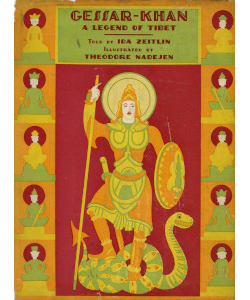Gessar Khan: A Legend of Tibet (Adaptation)

Content:
Epic of King Gesar
Illustrator:
Theodore Nadejen
Ida Zeitlin
Publication:
1927 by George H. Doran Company
Genre:
Fiction, Folk Tales, Historic Tales and Legends, Poetry
Current state:
Basic information has been added for this book.
It is under consideration and will be updated when it is evaluated further.
Book Guide
Search for this book used on:
The story of Gessar Khan, or Gesar of Ling, as it is told here comes from north India or possibly Mongolia, but the earliest tales told of him were told in the wild lands of eastern Tibet, the country of the Khans. The first episodes were probably chanted by bards at campfires, ten to twelve centuries ago and may have been based on the deeds of some warrior chief who lived in the seventh or eighth century, the great days of Tibetian military glory. The stories spread through all of northeastern Asia, and the first translation into a European language was made in 1839, by a German from the Mongolian version. Since then other visitors to the region have translated other versions as well. The stories are still told in Tibet today, as they have been for centuries, and they are sometimes thought to have a protective power. Travelers sing the songs of Gessar as they go, feeling that they are then protected from bandits.
Gessar Khan was born because the gods felt a leader was needed to bring order to earth and surpress injustice and violence. Miraculous signs attended the birth of the baby whose father was a god. The king of the region recognized the signs and feared the baby who would one day become king. When all attempts to kill the child failed, the king drove Gessar and his mother into the wilderness. Life there was hard and poor, but when the proper time arrived, Gessar, posing as Yoro, claimed the heritage to which he had been born.
From Hero Tales From Many Lands


